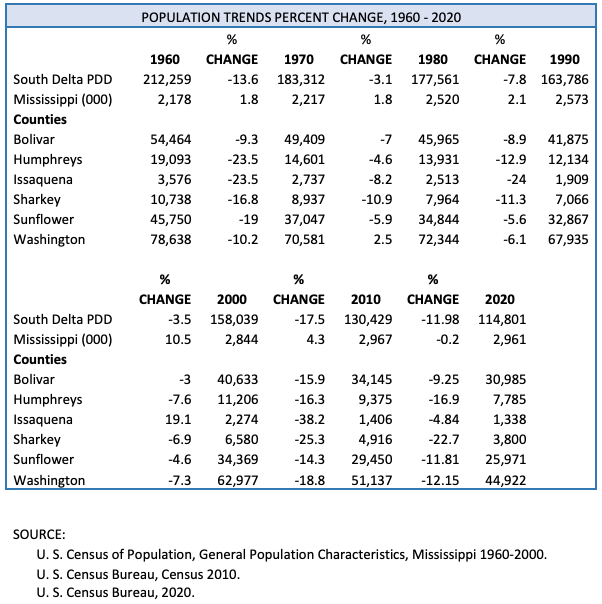Summary Background
POPULATION & DEMOGRAPHICS
South Delta Planning and Development District includes 41 units of local government. Six counties and thirty-five municipalities make up that number. The counties served by the Planning and Development District are Bolivar, Humphreys, Issaquena, Sharkey, Sunflower and Washington. The regional analysis section of this document serves to give insight into the traits and characteristics that make up the area known as South Delta. Population and demographics, clusters, infrastructure, financial resources and external forces will be looked at from a regional standpoint as well as on a county-by-county basis.

Total Population
116,399
South Delta PDD

Unemployment Rate
4.2%
South Delta PDD

High School Graduate or Higher
79.06%
South Delta PDD

Civilian Labor Force
45,315
South Delta PDD
South Delta is comprised of 3,602 square miles of land area. That equates to approximately 8% of Mississippi’s land area. Based on U. S. Census Bureau 2020 Population figures, there are 118,263 people living in the South Delta region. This is only 3.8% of the 2020 Mississippi population. The population of the District and the State of Mississippi, between 2010 and 2020, decreased by 11.98% and .20% respectively. Until 2020 the State had consistently shown an increase in population. The district, however, has had an average decrease in population of 9.58% at every Census since 1960. The 2010 Census showed a District population decrease of 17.5%, the largest decline since the 1960 Census.
South Delta Planning and Development District experienced a total population decline of 44.75% from 1960 to 2020. The majority of the district’s population resides in three of the six counties. These three counties – Bolivar, Sunflower and Washington – have over 88.74% of the population. Going hand in hand with this is the fact that the majority of the civilian labor force resides in and is employed in these three counties. Residents of the three smaller counties, the three southern counties of the district, must obtain employment from the limited opportunities in each county. Those unable to find employment within their own county must commute to the surrounding areas.

Generally, it can be stated that there are certain prevalent population, labor force, income and educational trends in the South Delta District that have existed throughout the last 60 years and are still present in varying and/or worsening degrees today. In the past, the district’s economy was based almost solely on agriculture. With the advent of mechanized farming, the need for laborers who possessed very little education and few job skills diminished drastically. Laborers were forced to seek employment elsewhere, usually in the industrialized cities of the North. In 2022, just as in 2012 and 2017, the district can be described as a persistently distressed area experiencing a continuing decline in population due to out-migration and death; unemployment rates that are high; median family incomes that are extremely low; numbers of persons living below the poverty level are high and educational levels that are below standard.
The population of the district has declined by approximately 97,458 persons between 1960 and 2020. While all counties in the district have experienced significant population losses during the past several decades, Sharkey County has experienced the greatest loss in percentage of population. Sharkey County lost 64.61% of its population during the period 1960-2020, while Issaquena County followed closely with a population of loss of 62.58%. In terms of absolute numbers, Washington County lost the greatest amount of population during the same period amounting to over 33,000 persons.
A decreasing population is currently the most concerning threat to the South Delta area. The decline in population was previously considered to be mostly a product of outmigration, “brain drain”. Now the long-term impacts of “brain drain/outmigration” are truly becoming apparent. During the period from 1990-99 there were 26,767 births in the district. Between 2010 and 2017 the number of births in the district had decreased by 51.5% to 12,981. In the period of 2017 through 2021 births had dropped to 7,332. The number of deaths in the district,10,557, during the same period, 2010 – 2017, resulted in a natural increase of 2,424. Despite the fact that births in the district outnumbered deaths, overall population continued to decline. Now during the period of 2017 through 2021 deaths, 8,437, outpaced births accelerating the rate of population decline. Out migration/brain drain, although no longer the major contributing factor of population decline, remains a concern for the region.
Based on the 2016 U. S. Census American Community Survey Data, the District’s median age was 36 years while Mississippi’s was 36.7 and the United States’ 37.7. According to the 2020 U. S. Census American Community Survey, the District’s median age increased to 38.7 years while Mississippi’s increased to 37.7 and the United States to 38.2. The district’s median age in 1960 was 19.9 years indicating the district’s population is continuing to age. Of the district’s population in 2016, 35.8% were 0-24 years old while 13.4% were 65 years of age or older. This left 50.8% of the district’s population in the productive working age group of 25-64. As the overall population of the region has declined these numbers have shifted slightly. In 2020 34.26% of the population was in the age range of 0-24 and 15.86% were over the age of 65. This has left 49.88% of the population in the productive working age range.
The fact that there is no major shift in any one of these segments of the population gives the impression that outmigration/brain drain is still the major contributing factor to the overall population decline. There will be no drastic upward changes in population unless there are significant changes in economic conditions and the perception of these conditions.
Until opportunities and quality of place improve, the steady out-migration of population will continue. Therefore, efforts must be placed on retaining and attracting population to the area. The “brain drain” must be addressed. Arresting the “brain drain” and drawing younger, educated individuals either back to the area or to it for the first time always brings about the age old “chicken and egg” conundrum. Which comes first? Do you focus on recruiting industry with the idea that younger people will come to the jobs? Do you focus on attracting the younger people in the hopes that industries will choose to locate where the bright, young, well-educated work force is located? Unfortunately, people can’t live on good intentions and growing an area out of nothing. The industry side of this equation should come first but with an initial focus on industry that can utilize a somewhat transient work force until locals are trained and additional population is attracted to the area. The trend of out-migration, especially among the college aged/young adult groups, cannot continue. Everything else that leads to a turnaround in the fortunes and livability of the district depends on having a younger, educated and energetic population in the area.
